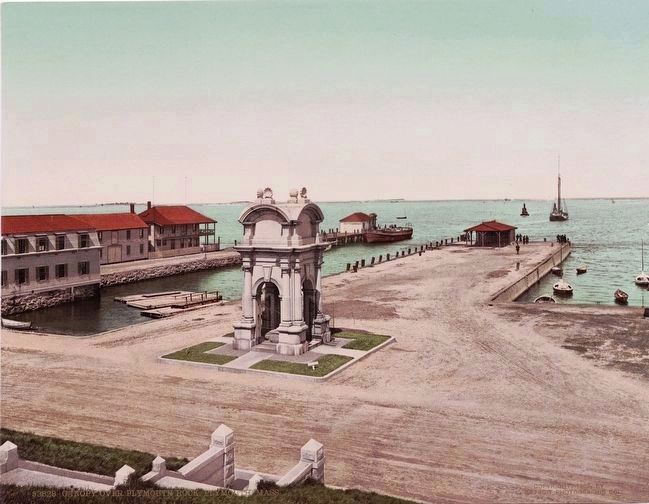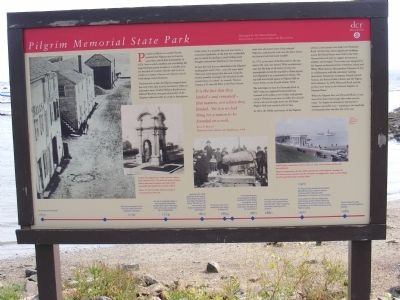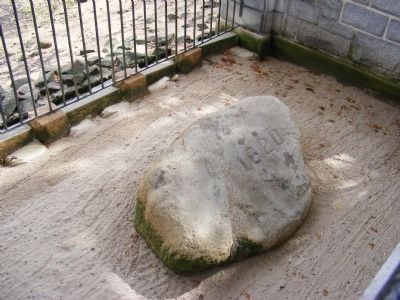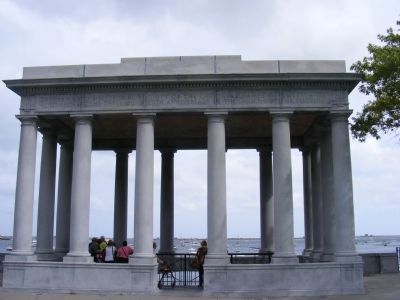Plymouth in Plymouth County, Massachusetts — The American Northeast (New England)
Pilgrim Memorial State Park
Tradition tells us that the Pilgrims stepped upon this rock when they arrived, but history offers an alternative story. Neither William Bradford nor Edward Winslow, two great chroniclers of the Pilgrim’s endeavor, refer to a rock in descriptions of the scene. It is possible the rock was merely a convenient landmark, or base for a makeshift pier to which the shallop (a small sailing vessel brought on board the Mayflower) was moored.
In fact, the rock was not identified as the Pilgrims’ landing place until 1741—over 120 years later! That year, word spread that the rock would be buried, possibly to prepare the shoreline for the construction of a wharf. As a result, Thomas Faunce, a 95 year-old Elder in the First Church (and who also knew some of the original Pilgrims), said that the rock was the place where the first arrivals had made landfall.
In 1774, at the start of the Revolution, the top half of the rock was removed. With Revolutionary zeal and the help of 30 teams of oxen, the townspeople moved the top half to Town Square and displayed it as a monument to liberty. The top half was moved again, to Pilgrim Hall on Court Street, on the Fourth of July, 1834.
The tide began to turn for Plymouth Rock in 1867 when the neglected bottom half was trimmed to fit within a new Gothic style granite canopy. Thirteen years later in 1880, the top half of the rock was brought down the hill from Pilgrim Hall and reunited with its base.
In 1921, the 300th anniversary of the Pilgrims’ arrival, a new portico was built over Plymouth Rock. At that time, many significant buildings across the United States were built in the Neo-Classical Revival style to suggest permanence, stability and strength. The portico was designed by the famous architectural firm of McKim, Mead and White (Penn Station, Metropolitan Museum of Art) in collaboration with the structural vaulting innovators Guastavino Company (Grand Central Station, the Boston Public Library and the Pilgrim Hall addition). In 1970, Plymouth Rock and the portico were listed in the National Register of Historic Places.
When the Pilgrims first saw Plymouth Rock, it was more than three times larger than what you see today. Yet despite its alterations and travels it remains a powerful icon-inspiring to the hundreds of thousands who visit this site every year.
It is the fact that they landed—and remained—that matters, not where they landed. Yet it is no bad thing for a nation to be founded on a rock.-Rose T. Briggs-Plymouth Rock: History and Significance, 1968 (Photo left side) At left: The original base of the rock sat within a busy wharf in 1855. The rock was swept off from time to time and a hammer and chisel were reportedly kept nearby for souvenir seekers. Above: In 1867 Gothic Revival canopy is constructed over the rock.
(Photo right side) Left: During construction of the portico in 1920, the two halves of the rock are stabilized. Above: In preparation for the 300 anniversary of the Pilgrims’ landing, the old wharves were removed and the shoreline reconfigured to create a park setting for Plymouth Rock that remains today. Timeline at the bottom of the marker: 1620-The Pilgrims land at Plymouth: 1741-Elder Faunce identifies the rock as the first landing site of the “Mayflower” passengers; 1774-The rock is accidentally broken in two, horizontally, while being moved to Town Square. The bottom half is left in place and becomes part of Hedges Wharf; 1820-Speaking at the 200th anniversary of the landing, Daniel Webster appears to have begun the legend by stating “Beneath us is the rock on which New England received the feet of the Pilgrims.” 1834- The top half of the rock is moved from Town
Square to Pilgrim Hall; 1867-A monumental granite canopy designed by Pilgrim descendant Hamatt Billings is completed. During construction, the lower half of the rock is trimmed to fit the new structure; 1880-The top of the rock is returned to the harbor and reunited with the base. The date “1620” is carved on the surface, replacing painted numerals; 1920-The Pilgrim Society transfers the land where Plymouth Rock rests to what is now the Commonwealth of Massachusetts’ Department of Conservation and Recreation); 1921-A new portico over the rock, designed by world-famous architects McKim Mead and White and the Guastavino Company, is built to commemorate the 300th anniversary of the Pilgrims’ landing; 1989-Mortar holding the upper portions of the rock together is replaced.
Erected by Massachusetts Department of Conservation and Recreation.
Topics. This historical marker is listed in this topic list: Settlements & Settlers. A significant historical month for this entry is July 1834.
Location. 41° 57.492′ N, 70° 39.726′ W. Marker is in Plymouth, Massachusetts, in Plymouth County. Marker is on Water Street. Touch for map. Marker is in this post office area: Plymouth MA 02360, United States of America. Touch for directions.
Other nearby markers. At least 8 other markers are within walking distance of this marker. Massasoit (within shouting distance of this marker); Plymouth Rock (within shouting distance of this marker); Welcome To Mayflower II
(within shouting distance of this marker); America's Hometown (within shouting distance of this marker); James Cole (within shouting distance of this marker); Pilgrim Mother Statue (within shouting distance of this marker); National Day of Mourning (within shouting distance of this marker); First Burying Ground of Mayflower Passengers (about 300 feet away, measured in a direct line). Touch for a list and map of all markers in Plymouth.

Photochrom postcard by the Detroit Photographic Company, 1902
5. Canopy over Plymouth Rock, Plymouth, Massachusetts
Prior to the portico constructed in 1920, as depicted in the third picture, Plymouth Rock was protected by the canopy depicted on this postcard, constructed in 1867.
Image courtesy of the Yale Collection of Western Americana, Beinecke Rare Book and Manuscript Library.
Credits. This page was last revised on June 16, 2016. It was originally submitted on January 7, 2013, by Don Morfe of Baltimore, Maryland. This page has been viewed 839 times since then and 35 times this year. Photos: 1, 2, 3, 4. submitted on January 7, 2013, by Don Morfe of Baltimore, Maryland. 5. submitted on August 29, 2015. • Bill Pfingsten was the editor who published this page.



